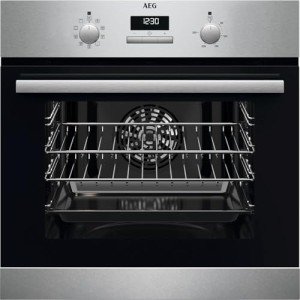
Single Ovens For Sale
Add a review FollowOverview
-
Founded Date August 15, 2008
-
Sectors Finance and Banking
-
Posted Jobs 0
-
Viewed 21
Company Description
Ten Single Fan Ovens That Really Change Your Life

Understanding Single Fan Ovens: A Comprehensive Guide
Introduction
As modern kitchen areas grow progressively sophisticated, appliances created for efficiency and performance are at the forefront of customer interest. One such device that stays popular amongst home cooks and baking lovers is the single fan oven, an electric design understood for its flexibility and ease of usage. This post provides thorough details about single fan ovens, including their performance, advantages, types, and considerations for purchase.
What is a Single Fan Oven?
A single fan oven, also called a stove, features a single cooking chamber with a fan and exhaust system that distributes hot air consistently throughout the cooking space. This results in an even cooking temperature level and boosted cooking efficiency compared to standard static ovens.
Secret Components of a Single Fan Oven
- Heating Elements: Usually located at the top and bottom, these create heat for cooking.
- Fan: The main feature that distributes the hot air within the oven, promoting faster and more even cooking.
- Thermostat: Regulates the temperature to make sure optimum cooking conditions.
- Control board: Provides user interface options for setting temperature levels, cooking times, and modes.
How Does a Single Fan Oven Work?
Single fan ovens run by combining the heat from the heating components with the air motion created by the fan. The hot air is distributed equally around the food, significantly decreasing cooking time while likewise enabling lower cooking temperatures.
Advantages of Using a Single Fan Oven
- Faster Cooking Times: The circulating air allows food to prepare faster compared to traditional ovens.
- Even Cooking: Food is exposed to consistent heat from all sides, decreasing the chances of unequal cooking or locations.
- Versatility: These ovens can be used for baking, roasting, and even barbecuing, making them appropriate for a wide range of dishes.
- Energy Efficiency: By cooking at lower temperatures and in less time, these ovens may utilize less energy than their standard counterparts.
- Moisture Retention: The design helps retain moisture in meals, leading to juicy roasts and baked goods with a light texture.
Types of Single Fan Ovens
When considering a single fan oven, customers might experience various types based upon functions and style. Here are a few common types:
1. Built-in Single Fan Ovens
- Description: Integrated into kitchen cabinets for a seamless look.
- Pros: Saves counter space, visually pleasing.
- Cons: Higher setup expenses, may need professional help.
2. Freestanding Single Fan Ovens
- Description: Standalone systems that can be placed anywhere in the kitchen.
- Pros: Easy to install, versatile placement.
- Cons: Can use up more area, may not mix well with cabinetry.
3. Range Cookers with Fan Ovens
- Description: Multiple cooking alternatives, consisting of a fan oven, integrated in one unit.
- Pros: Offers different cooking methods, ideal for enthusiastic cooks.
- Cons: Generally more costly, bigger footprint.
Comparison Table of Single Fan Oven Types
| Type | Pros | Cons |
|---|---|---|
| Built-in | Space-saving, aesthetically pleasing | Higher costs, professional setup needed |
| Freestanding | Flexible positioning | Uses up more area, may not match cabinets |
| Range Cooker | Several cooking techniques | Greater price, larger size |
Selecting the Right Single Fan Oven
When deciding on a single fan oven, several elements must be considered to make sure that it meets personal cooking needs and fits within your kitchen design.
Elements to Consider
- Size and Capacity: The size ought to complement your kitchen layout while using enough capacity for your cooking practices.
- Features and Functions: Look for adjustable racks, self-cleaning choices, and multiple cooking modes to improve flexibility.
- Energy Efficiency: Check for energy scores; some designs are developed to be especially energy-efficient.
- Budget plan: Costs can differ considerably, making it essential to establish a reasonable spending plan ahead of time.
Maintenance Tips for Single Fan Ovens
- Regular Cleaning: Wipe down interior surfaces after usage to prevent residue build-up.
- Check the Fan: Ensure the fan is devoid of obstructions and working correctly.
- Examine Seals: Regularly examine the door seals for wear and tear to keep cooking efficiency.
- Expert Servicing: Schedule routine expert checks to guarantee optimum operation.
FAQs about Single Fan Ovens
1. Can I utilize my single fan oven for baking?
Definitely! Single fan ovens are exceptional for baking, supplying consistent temperatures important for cakes, cookies, and breads.
2. Is it required to preheat a single fan oven?
While pre-heating is usually recommended for ideal outcomes, due to the efficiency of a fan oven, some recipes may not need it.
3. Can I prepare numerous dishes at when?
Yes! The even heat circulation in single fan ovens allows you to bake or roast numerous meals at the same time, using all rack levels effectively.
4. Does a single fan oven cook faster than a traditional oven?
Yes, the fan-assisted heating lowers cooking times, making it possible for faster cooking.
Single fan ovens offer an extraordinary balance of speed, adaptability, and effectiveness, making them an important addition to any kitchen. Whether for baking, roasting, or everyday cooking, these ovens guarantee that home cooks can produce scrumptious meals with ease. By understanding the benefits, types, and factors to consider for purchasing a single fan oven, customers can make an educated choice that lines up with their cooking desires and kitchen characteristics.
Welcoming the performances of a single fan oven unquestionably leads the way for enhanced cooking experiences in the contemporary kitchen.
